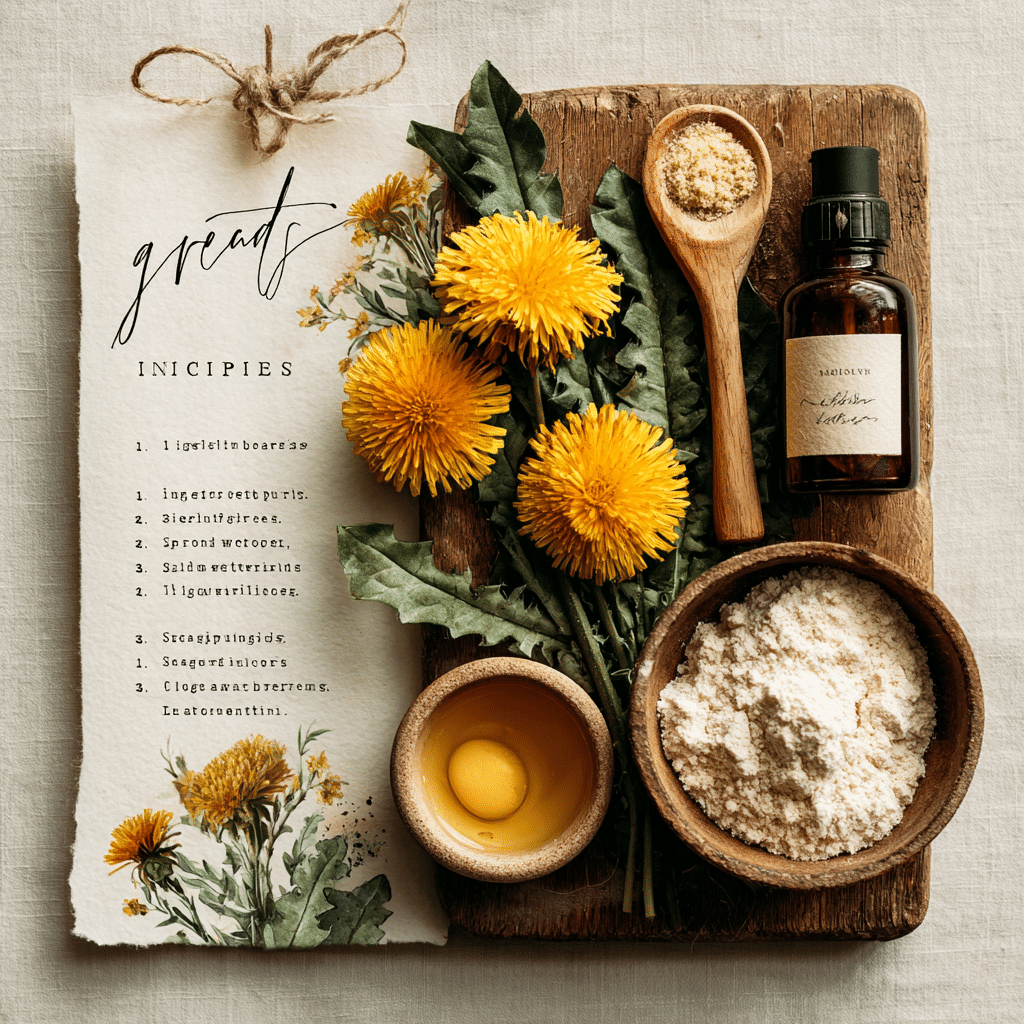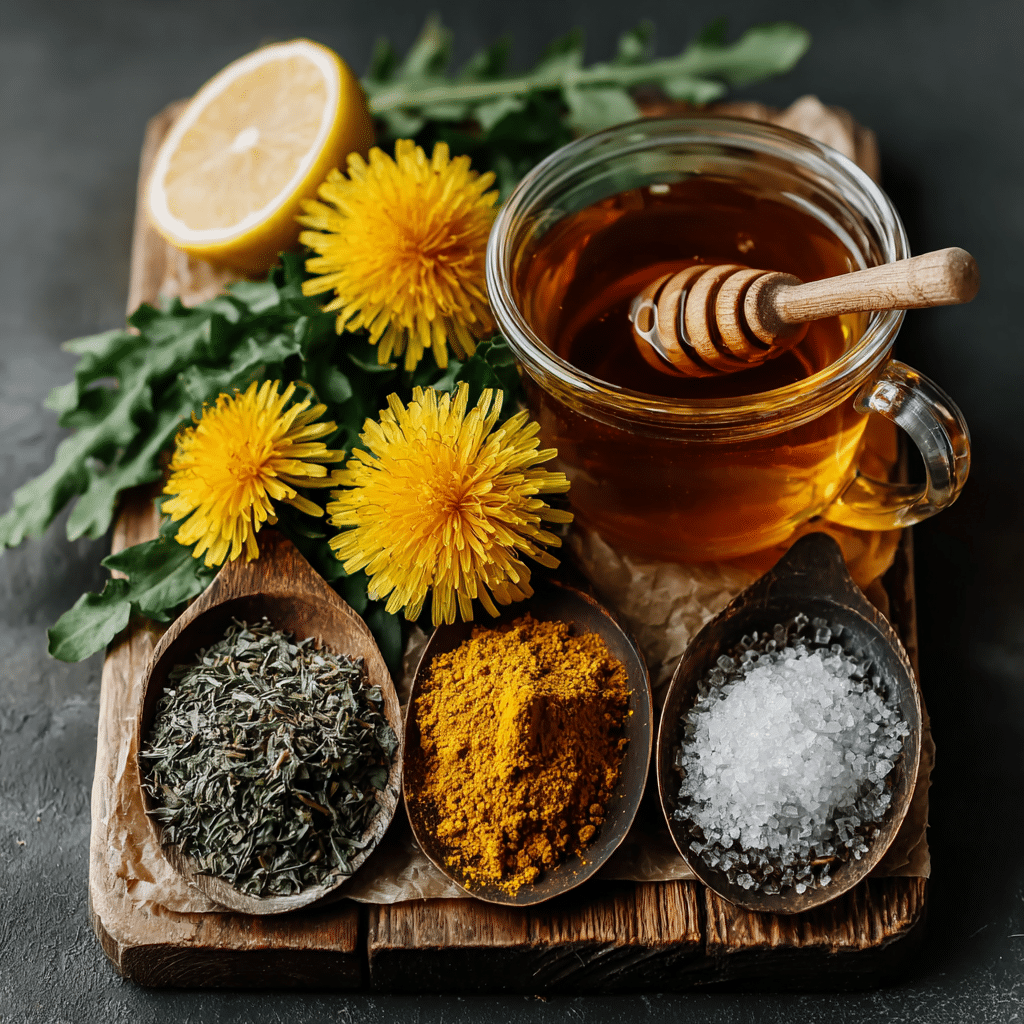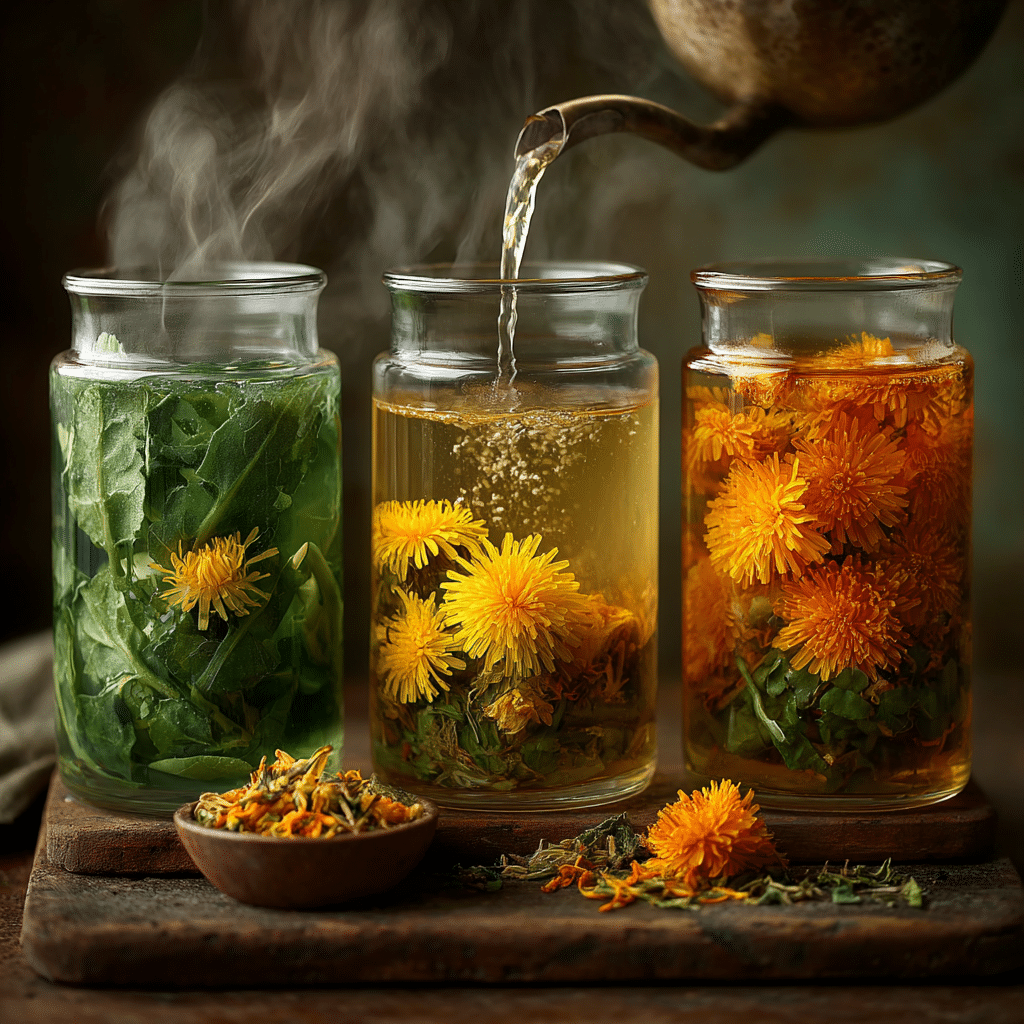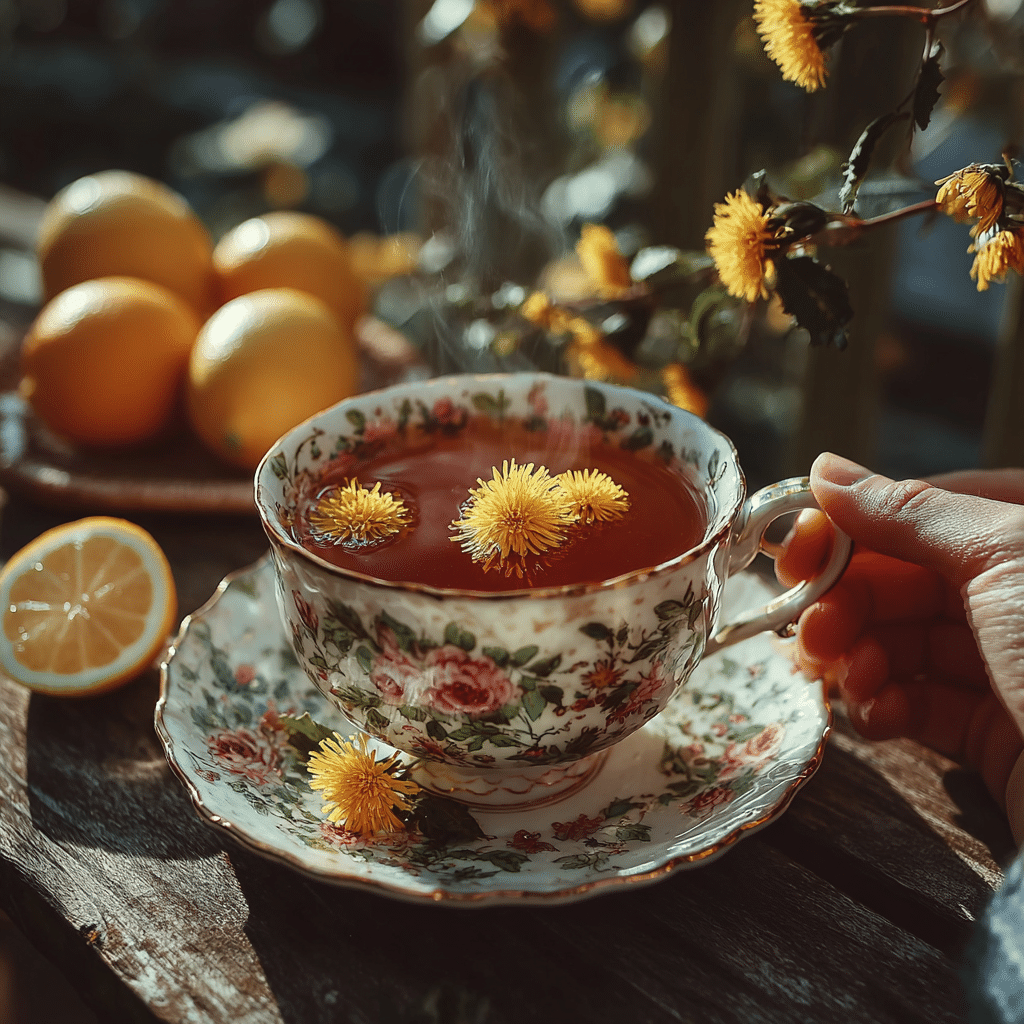Looking for a natural and refreshing herbal drink? A well-prepared dandelion tea recipe can do more than quench your thirst. Dandelion tea is rooted in tradition and known for its health-boosting properties. This guide will walk you through the ingredients, preparation, and benefits of this vibrant tea, perfect for daily wellness. Whether you harvest fresh dandelions or opt for store-bought dried leaves, this recipe offers a simple and effective way to enjoy the goodness of nature in a cup.
If you’re interested in natural detox teas, dandelion is one of the most effective and gentle options you can add to your routine.
What You’ll Find Here

Dandelion Tea Recipe – Natural Wellness in Every Cup
Ingredients
Method
- 1. Rinse dandelion parts thoroughly under cool water.
- 2. Boil filtered water to a rolling boil.
- 3. Place dandelion ingredients in a teapot or infuser.
- 4. Pour hot water over herbs and steep for 10–15 minutes.
- 5. Strain the tea into a cup.
- 6. Add lemon or honey if desired.
- 7. Serve hot or chill for iced tea.
Notes
Tried this recipe?
Let us know how it was!Health Benefits of Dandelion Tea
Dandelion tea recipe benefits
One of the top reasons people search for a dandelion tea recipe is the potential health impact. Dandelions are rich in vitamins and antioxidants that support your overall well-being. The leaves, roots, and flowers all bring something different to the table. When brewed into a soothing tea, they offer gentle cleansing, hydration, and cellular protection.
Drinking tea from this recipe regularly can improve digestion, provide liver support, and help maintain a balanced immune system. Here’s why dandelion tea stands out:
| Nutrient | Benefit |
|---|---|
| Vitamin A | Boosts vision, skin health, and immune function |
| Potassium | Regulates hydration and supports heart rhythm |
| Polyphenols | Reduces inflammation and supports detox |
Natural detox and immune support
A strong dandelion tea recipe includes flowers and roots for a full spectrum of benefits. This tea naturally promotes liver health by stimulating bile production, which aids digestion and detoxification. The leaves provide a mild diuretic effect, helping your body release excess fluids without depleting potassium.
In addition to flushing out waste, this dandelion tea recipe supports your immune system with antimicrobial compounds. For those avoiding caffeine, it’s a perfect herbal alternative with gentle daily support. Many enjoy it in the evening as part of a relaxing routine that also nurtures their internal health.
Dandelion Tea Ingredients
What you need for a dandelion tea recipe
To follow a traditional dandelion tea recipe, you’ll need a few simple ingredients. You can use fresh or dried dandelion parts, depending on availability and preference. The recipe works with dandelion roots, leaves, or flowers—or a mix of all three. Each part offers unique flavors and nutrients, enhancing the overall experience.
Here’s a simple list of ingredients typically used in a dandelion tea recipe:
| Ingredient | Purpose |
|---|---|
| Fresh dandelion flowers | Provides a light, floral aroma and subtle sweetness |
| Dried dandelion leaves | Adds mild bitterness and nutrients |
| Dandelion root (roasted or raw) | Offers earthy, rich flavor and supports liver health |
| Filtered water | Essential for brewing and extracting nutrients |
You may also add optional ingredients like lemon slices, cinnamon sticks, ginger, or honey to tailor the flavor of your dandelion tea recipe.
Choosing fresh vs. dried dandelion flowers
When selecting ingredients for your dandelion tea recipe, the choice between fresh and dried matters. Fresh flowers offer a lighter, fragrant tea and are best harvested from areas free of pesticides and lawn chemicals. If you opt for fresh, rinse them well to remove any dirt or insects before use.

Dried dandelions are more concentrated in flavor and can be stored year-round. You can buy organic dried flowers and leaves online or dehydrate your own. Whichever you choose, the quality of your dandelion tea recipe depends on clean, chemical-free plants. Avoid roadside dandelions or those from sprayed areas.
Using fresh or dried, you can craft a delicious and effective dandelion tea recipe with just a few natural ingredients.
Dandelion Tea Preparation Steps
How to prepare dandelion flowers for tea
Proper preparation is essential for getting the best results from your dandelion tea recipe. Start by collecting fresh dandelion flowers early in the morning when they are fully open. Rinse them gently under cool water to remove dirt and small insects. If you’re using the roots, scrub them well and slice them thinly.
Dry the cleaned flowers and leaves on a paper towel or in a mesh strainer for a few minutes. For a stronger flavor, you can roast dandelion roots at 350°F (175°C) for 10–15 minutes until dark brown—this creates a coffee-like aroma perfect for a bold tea base.
Whether you use fresh or dried parts, keep your portions even. Aim for 1–2 teaspoons of dried dandelion or 1 tablespoon of fresh parts per cup of water in your dandelion tea recipe.
Brewing method for best flavor
A solid brewing technique helps you get the full value from your dandelion tea recipe. Here’s how to do it:
- Boil water – Bring 8 to 10 ounces of filtered water to a rolling boil.
- Add dandelion parts – Place your measured dandelion roots, leaves, or flowers into a teapot or infuser.
- Steep properly – Pour hot water over the herbs and let steep for 10–15 minutes. For roots, steeping up to 20 minutes boosts potency.
- Strain and serve – Strain your tea into a cup. Add lemon or honey if you prefer.

For convenience, prepare a large batch using a saucepan. Use 4 cups of water and 4 tablespoons of fresh dandelion parts. Simmer uncovered for 20 minutes, then strain and refrigerate.
This step-by-step process ensures your dandelion tea recipe turns out flavorful, soothing, and beneficial. Always use clean tools and glass or stainless-steel containers to avoid contamination or bitterness.
Flavor Enhancements & Variations
Adding herbs and spices to dandelion tea
A dandelion tea recipe is flexible and blends well with other herbs. To improve flavor and benefits, you can mix in natural additions that complement dandelion’s earthy taste. Popular herbal enhancements include:
- Mint leaves – Adds a refreshing cooling note
- Ginger slices – Offers a spicy edge and digestive support
- Cinnamon sticks – Brings warmth and subtle sweetness
- Turmeric – Boosts anti-inflammatory effects
To infuse these flavors, add them during the steeping stage. Just one or two added ingredients can transform a basic dandelion tea recipe into something special. Make sure all herbs are food-grade and pesticide-free.
Sweeteners and citrus tips
If the slight bitterness of your dandelion tea recipe needs softening, sweeteners and citrus can help. Try natural, low-impact options that preserve the health benefits of the tea:
- Raw honey – Adds sweetness and antimicrobial properties
- Maple syrup – Provides depth and mild sweetness
- Lemon juice – Cuts bitterness and increases vitamin C
Avoid artificial sweeteners or heavy sugar, which can overwhelm the subtle herbal notes. Add citrus or honey just before serving, after steeping is complete.
You can also experiment with cold brews. Simply steep the tea ingredients in cold water overnight, then strain and serve over ice with a lemon wedge. This chilled version of a dandelion tea recipe works well in warm weather and offers a milder taste profile.
Personalizing your brew with these simple enhancements makes every cup of dandelion tea enjoyable and tailored to your taste. The base recipe remains the same, but these variations can add excitement and variety.
For those who enjoy warm herbal drinks with a unique twist, this hojicha latte recipe offers a roasted, soothing flavor similar to roasted dandelion root.
Dandelion Tea Serving Suggestions
Best ways to enjoy dandelion tea
Serving dandelion tea is about more than just pouring it into a mug. The right presentation enhances your experience and makes the health ritual more enjoyable. After preparing your dandelion tea recipe, choose a cup or teapot that retains heat well—glass, ceramic, or insulated stainless steel are best.
Serve the tea warm for maximum aroma and comfort. Add a cinnamon stick or lemon slice as garnish for visual appeal and flavor. If drinking cold, pour over ice and add mint for a crisp twist. Dandelion tea also pairs nicely with light snacks like rice crackers or fresh fruit slices.
Whether hot or iced, keep your tea unsweetened if you’re using it as a detox or herbal tonic. Sip slowly to absorb its gentle effects.
Serving temperature and pairings
Temperature matters when following a dandelion tea recipe. Hot tea promotes circulation and is ideal in cooler months or after meals. Iced dandelion tea refreshes and hydrates, especially during spring and summer.
Here’s a quick guide:
| Serving Style | Best Time | Pairing Idea |
|---|---|---|
| Hot | Morning or after meals | Oat biscuits, dried fruit |
| Iced | Afternoon or post-exercise | Fresh berries, citrus salad |
A dandelion tea recipe works well in detox regimens, light meals, or as a mid-day break. With the right pairings and presentation, your herbal tea becomes a satisfying and nourishing ritual.
Pair your iced dandelion tea with hydrating options like this cucumber lemon mint water for a refreshing afternoon detox.

Storage and Shelf Life
How to store prepared dandelion tea
After brewing your dandelion tea recipe, proper storage helps preserve its freshness and nutrients. Let the tea cool completely before transferring it to a glass jar or airtight container. Always use a clean container to prevent bacteria or off-flavors from developing.
Refrigerate brewed tea within 1 hour. It’s best to consume the tea within 3 days for full flavor and benefits. Label the container with the date to keep track. Avoid storing in plastic, as it may affect the taste or introduce unwanted chemicals.
If you prefer prepping in batches, freeze leftover tea in ice cube trays. These herbal cubes can be used later in smoothies or as cold additions to your next cup of dandelion tea.
Shelf life of dried and brewed tea
Whether using store-bought or home-harvested plants, ingredient freshness affects your dandelion tea recipe. Dried dandelion roots, leaves, and flowers last up to 12 months when stored properly:
- Keep dried herbs in a cool, dark place
- Store in sealed glass jars or tins
- Avoid moisture and direct sunlight
Here’s a breakdown of storage expectations:
| Form | Shelf Life | Storage Tip |
|---|---|---|
| Dried dandelion parts | 6–12 months | Keep airtight, away from light |
| Brewed dandelion tea | Up to 3 days (refrigerated) | Glass container, tightly sealed |
Your dandelion tea recipe delivers the best results when ingredients are fresh and tea is stored safely. Avoid extended exposure to air, moisture, or heat, which can degrade quality and flavor.
If you’re exploring different detox options, this cleanse detox juice complements dandelion tea and stores just as easily.
Potential Side Effects & Safety
Side effects of drinking dandelion tea
While a dandelion tea recipe is generally safe for most people, it’s important to know that even natural remedies can cause side effects. Dandelion may act as a diuretic, which increases urination. This can lead to mild dehydration if you don’t replenish fluids.
Some individuals report stomach discomfort, acid reflux, or allergic reactions after consuming dandelion tea. Common symptoms may include:
- Mild bloating
- Upset stomach
- Skin rash or itchiness
- Heartburn
If you’re trying this dandelion tea recipe for the first time, start with a small amount. Observe how your body reacts before increasing your intake. If any symptoms persist, discontinue use and speak with a healthcare professional.
Interactions with medications
A well-prepared dandelion tea recipe may interact with certain medications. If you’re taking diuretics, lithium, blood thinners, or medications for diabetes or blood pressure, consult your doctor before drinking this tea regularly.
The compounds in dandelion can affect liver enzymes and alter how your body processes medications. Here are common interaction concerns:
| Drug Type | Potential Interaction |
|---|---|
| Diuretics | May increase risk of dehydration |
| Anticoagulants | Could affect blood clotting |
| Antidiabetic drugs | May enhance blood sugar lowering effects |
Always disclose herbal tea consumption to your healthcare provider, especially if you’re under medical treatment. Even a natural dandelion tea recipe should be part of an informed health plan.
For extra inflammation-fighting power, this turmeric powder shot recipe pairs well with your herbal tea routine.
Tips for Growing & Harvesting
Harvesting dandelion flowers safely
To get the best flavor and health benefits from your dandelion tea recipe, proper harvesting is essential. Choose dandelions that grow in clean, chemical-free areas—ideally your own garden or a trusted wild patch far from roads or sprayed lawns.
Pick flowers in the morning when they’re fully open. Use scissors or pinch the blooms gently to avoid damaging the stem. Harvest young, vibrant flowers for better taste and higher nutrient content. Rinse thoroughly to remove insects and dirt before use or drying.
You can also collect young leaves and tender roots during spring or early fall. Each part contributes to a complete dandelion tea recipe with layers of earthy, floral, and bitter notes.
Growing your own dandelion for tea
Cultivating dandelions at home ensures a safe, steady supply for your dandelion tea recipe. They’re hardy, grow easily, and require minimal maintenance. Plant seeds in full sun and well-draining soil. Water lightly and avoid over-fertilizing, as this can reduce the potency of medicinal compounds.
Let the plants grow for a few months before your first harvest. Regular pruning encourages fresh growth, while leaving some plants to seed allows natural propagation. Here are simple steps:
- Sow seeds directly in soil in early spring
- Thin seedlings to allow space for root development
- Harvest leaves when they’re 4–6 inches long
- Uproot roots in fall for maximum strength
Dandelions thrive without much care, making them perfect for herbal gardeners. By growing your own ingredients, you gain full control over the quality of your dandelion tea recipe from soil to sip.
For more recipes follow our social media accounts on Pinterest : Dieteverytime
FAQs
Can I use store-bought dried dandelion for tea?
Yes, store-bought dried dandelion leaves, roots, or flowers are safe and effective for any dandelion tea recipe. Make sure the product is organic and free from additives. Always check the expiration date for maximum potency and flavor.
How often is it safe to drink dandelion tea?
For most healthy adults, drinking dandelion tea once or twice a day is considered safe. If you’re new to it, start with one cup and monitor how your body responds. Overuse may lead to side effects like dehydration or digestive upset.
Can pregnant women drink dandelion tea?
Pregnant or breastfeeding women should consult a healthcare provider before using any dandelion tea recipe. Although dandelion has historical use in pregnancy, individual reactions vary, and safety studies are limited.
Does dandelion tea help with weight loss?
While no tea guarantees weight loss, a dandelion tea recipe may support your goals by reducing water retention and promoting digestion. It should be paired with healthy habits and not used as a sole weight-loss method.
Conclusion
A simple dandelion tea recipe delivers more than a pleasant taste—it offers a daily dose of herbal wellness. From natural detox support to immune-boosting nutrients, this tea fits effortlessly into any lifestyle. Whether you’re brewing from wildflowers or using store-bought dried parts, making dandelion tea is easy, affordable, and deeply rewarding. Try it hot or cold, straight or enhanced with citrus and herbs, and enjoy a natural health boost in every sip.
Disclamer
The information shared in this article is for educational and informational purposes only. It is not intended to replace medical advice, diagnosis, or treatment. These recipes and tips are based on personal experience and may not be suitable for everyone.
Always consult your physician, registered dietitian, or a qualified healthcare provider before making any dietary changes. Never disregard or delay professional medical advice based on content from this blog. Your health journey should always be guided by trusted medical professionals.


1 thought on “Dandelion Tea Recipe – Natural Wellness in Every Cup”